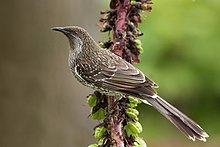Anthochaera chrysoptera
| Little wattlebird | |
|---|---|
 |
|
| Scientific classification | |
| Kingdom: | Animalia |
| Phylum: | Chordata |
| Class: | Aves |
| Order: | Passeriformes |
| Family: | Meliphagidae |
| Genus: | Anthochaera |
| Species: | A. chrysoptera |
| Binomial name | |
|
Anthochaera chrysoptera (Latham, 1801) |
|
The little wattlebird (Anthochaera chrysoptera), also known as the brush wattlebird, is a honeyeater, a passerine bird in the family Meliphagidae. It is found in coastal and sub-coastal south-eastern Australia.
The species was originally described by the ornithologist John Latham in 1801 under the binomial name Merops chrysoptera. Its specific epithet is derived from the Ancient Greek chryso "golden", and pteron "wing(ed)".
The International Ornithologists' Union recognise three subspecies:
The western wattlebird (A. lunulata) was at one time considered as a subspecies.
The little wattlebird is a medium to large honeyeater, but the smallest wattlebird. The appearance is similar to the yellow wattlebird and the red wattlebird. The little wattlebird lacks the wattles which characterise the wattlebirds.
Juveniles are duller with less streaking and have a browner eye.
The little wattlebird is found in banksia/eucalypt woodlands, heathlands, tea-tree scrub, sandplain-heaths, lantana thickets, wild tobacco, parks and gardens.
Calls include a strident cookay-cok, a raucous fetch the gun, a mellow guttural yekkop, yekkop and many squeaky, musical lilting notes. The alarm call is a kwock or shnairt!.
Breeding takes place from June to December. The female wattlebird generally constructs the nest, a loose, untidy cup of twigs lined with shredded bark and placed from 1 to 10m high in the fork of a banksia, tea-tree or eucalypt sapling. 1-2 eggs are laid and may be spotted red-brown, purplish red or salmon-pink in colour. The female incubates the eggs alone. Both sexes care for young chicks.
...
Wikipedia

